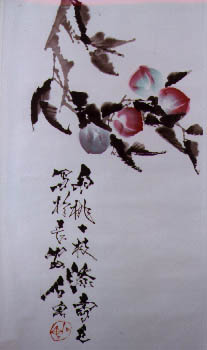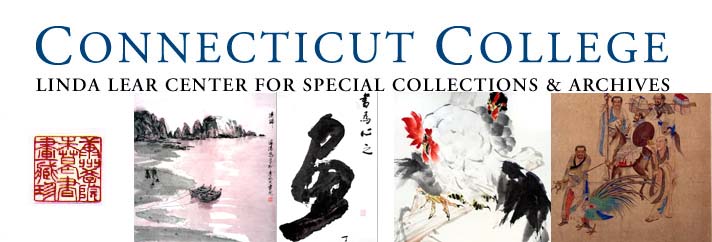Flowers, Insects, and Bird Paintings
Shih Lu (1919-1982)
Peaches
Hanging Scroll, Ink and Color on Rice Paper, 53.75 x 27 in., (136.5 x 69 cm.)
 I can not help but feel for Shih Lu. He was a talented, idealistic and artistic man whose life was full of adventure, frustration and tragedy, especially in the last twenty years of his life. His achievements, however, will always be recorded in the history of Chinese art.
I can not help but feel for Shih Lu. He was a talented, idealistic and artistic man whose life was full of adventure, frustration and tragedy, especially in the last twenty years of his life. His achievements, however, will always be recorded in the history of Chinese art.
Shih Lu was born to a landlord family in Sichwan. As a teenager he attended an art school for two years, then had two years in a university before the war started in 1937. Filled with patriotism and political ideals, he left home in 1939 for the north and a year later went to Yenan, the stronghold of the Communist party under Mao Ze-dong. He plunged right into art-related assignments such as drawing cartoons, stage designs and mass art to promote communist causes. He raised Mao's banner and even became a party member in 1946.
When the Communists took over China in 1949, Shih Lu was sent to Xian where he was a leader in both political and art organizations. Art became his main focus. He shifted his attention to traditional styles of painting, putting the mass art movement behind. However, socialist realism which had prevailed under the new regime still affected him. He coined a motto to remind himself and others that in painting one should "grasp tradition in one hand and grasp life in the other." Shih Lu's first decade in Xian was probably his most creative period. He sketched laboring people and painted sheep and goats on the highland and in the lofty mountains of the area. Among them was a painting (1959) entitled "Shifting to Fight in North Shaanxi," his province. In it, he painted a picture resembling the Chairman with a horse and two aides on top of a cliff looking at a long stretch of mountainous land. It was a strong and impressive work. During this time Shih Lu and a few others in Xian initiated the Xian School of art, referring to artists in their region. Today the school has faded, but the name remains.
During the next two decades, Shih Lu and innumerable others in all circles in China were swept before the storm of the Cultural Revolution, (1966-76.) He was a major target. The painting mentioned above was attacked for invented reasons, (Chairman was on the edge of a cliff in danger of falling.) Shi Lu was tortured, beaten, jailed, starved. His paintings were branded "crazy, odd, black and chaotic." Shih Lu continued to paint in the old-fashioned literati style. He often gave paintings as gifts to friends, showing his rebellion and spirit of individualism. Wine became a necessity. His health deteriorated. He was taken to Beijing for treatment in 1979 4. Three years later, on August 25, 1982, Shi Lu died at home in Xian.
The inscription translates as follows:
Ten branches of luscious peaches add to best wishes for longevity.
This painting was purchased with funds provided by John Faigle, Jr. ( '93), the Robert Farwells, the John Faulkners, the Gregory Gardiners, Jeanette Hersey, Kathy Willis and Susan Zimmerman in September, 1997.
